测试管理用户手册
WT-200用户手册V1.2--精通
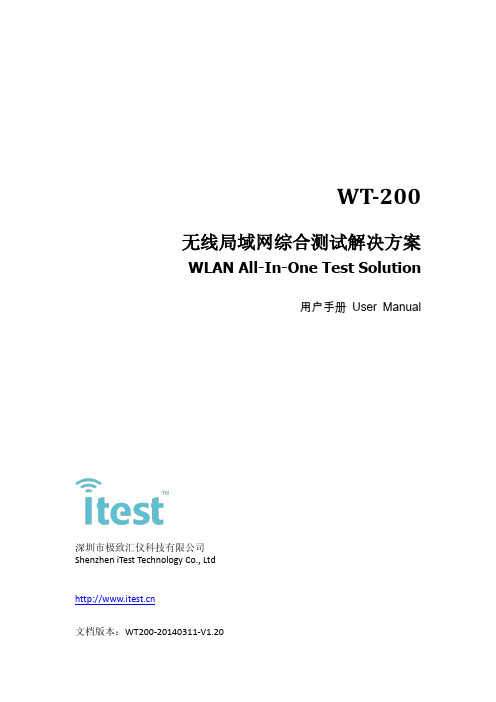
4.4. 菜单栏操作详解 ............................................................................................................... 24 4.4.1. 4.4.2. 4.4.3. File .......................................................................................................................... 24 Settings ................................................................................................................... 25 Help ......................................................................................................................... 30
2. 设备安装 ..................................................................................................................................... 4 2.1. 装箱清单 ............................................................................................................................. 4 2.2. 硬件连接 ............................................................................................................................. 4 2.2.1. 2.2.2. 2.2.3. 2.2.4. 接地线连接 .............................................................................................................. 4 电源线连接 .............................................................................................................. 5 网线连接 .................................................................................................................. 5 射频电缆连接 .......................................................................................................... 5
测量管理体系认证管理手册
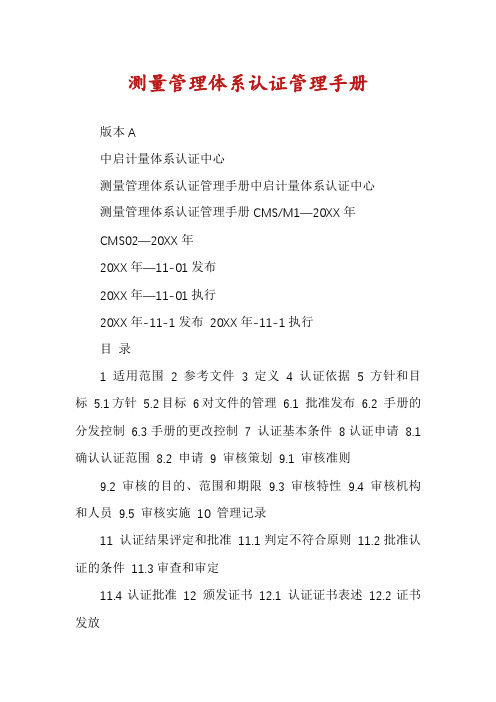
测量管理体系认证管理手册版本A中启计量体系认证中心测量管理体系认证管理手册中启计量体系认证中心测量管理体系认证管理手册CMS/M1―20XX年CMS02―20XX年20XX年―11-01发布20XX年―11-01执行20XX年-11-1发布20XX年-11-1执行目录1 适用范围2 参考文件3 定义4 认证依据5 方针和目标 5.1方针 5.2目标6对文件的管理 6.1 批准发布 6.2 手册的分发控制 6.3手册的更改控制7 认证基本条件8认证申请8.1确认认证范围8.2 申请9 审核策划9.1 审核准则9.2 审核的目的、范围和期限9.3 审核特性9.4 审核机构和人员9.5 审核实施10 管理记录11 认证结果评定和批准11.1判定不符合原则11.2批准认证的条件11.3审查和审定11.4认证批准12 颁发证书12.1 认证证书表述12.2证书发放13 保持认证的必要条件14 获得认证后的监督14.1 认证后监督的内容14.2 监督的频次14.3 监督的方式14.4 监督结果评价15 认证证书和认证标志的使用15.1认证标志15.2 认证标志的使用15.3认证证书15.4 认证证书的使用15.5 认证证书和认证标志的误用16 扩大认证范围17 认证的暂停、撤销和注销17.1 暂停认证的条件17.2 撤销认证的条件17.3 注销认证的条件18 重新认证19 认证要求更改20 保密21 责任22 纠纷23内部审核24 费用26 认证中心组织机构及其职权26.1 认证中心总部及其职权26.2非法人认证分支机构及其职权26.3审定委员会及其职权27 附则一个有效的测量管理体系是组织整个管理体系的一部分,它保证测量设备和测量过程满足顾客、组织和法律法规对计量的要求,它对增强顾客满意,实现组织目标,提高产品质量和经济效益,并管理不正确测量结果的风险是重要的。
测量管理体系的目标是确保具有与组织的生产经营相适应的计量检测能力,并管理测量设备和测量过程产生的、影响组织产品质量、安全生产和经济效益的不正确测量结果的风险。
测试计划、测试报告和用户手册的编写

正确认识测试计划
• 谁是测试计划的最终用户
– 测试计划的最终用户一般是研发团队 – 测试计划作为产品提交给用户(特殊需求、军方、外包测试用户)
• 关于测试计划的格式和内容
– 用户是研发团队:
• 测试计划的价值取决于它能在多大的程度上帮助你管理你 的测试项目和帮助你发现错误。
• 千万不要为了写测试计划而写测试计划,测试计划务必能 指导测试工作,切实具有可用性。
– 按具体功能划分小标题 • 建议采用提问方式设置标题
谢谢
按照角色划分 按照业务流程依次介绍
缺点
这样的写法可能不全面
特点 1 写法较复杂,需熟悉业务 2 以实际业务处理流程介绍 3 方便熟悉业务 4 这种形式的说明书很少见
举例:JIRA使用指南、淘宝网购物
业务介绍型
• 对角色操作进行总结归纳 • 按角色或权限划分大标题
– 按具体功能划分小标题 • 按用户实际使用划分标题
• 简单的套用模版,没有意义。
– 用户是特殊用户:
• 按用户要求填写
• 测试计划的编写 • 测试报告的编写 • 用户手册的编写
测试总结报告定义
• 测试报告文档是测试阶段最后的文档产出物,把测试的过程和结果写 成文档,并对发现的问题和缺陷进行分析,为纠正软件的存在的质量 问题提供依据,同时为软件验收和交付打下基础。
特点 1 写法简单,不需业务知识 2 单个模块容易理解 3 大多数说明书采用该方式
举例:学生信息管理系统、失业保险系统、QQ工具
功能介绍型
• 按系统模块划分标题 • 每个模块要先进行整体介绍 • 每个模块再进行功能点划分介绍
– 可列小标题 – 可插入层次划分符号 • 添加注意信息
写作方式(2)
用户手册测试用例
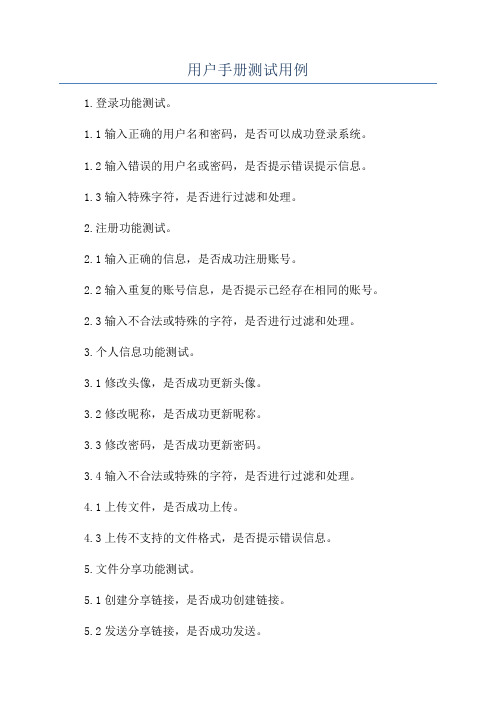
用户手册测试用例1.登录功能测试。
1.1输入正确的用户名和密码,是否可以成功登录系统。
1.2输入错误的用户名或密码,是否提示错误提示信息。
1.3输入特殊字符,是否进行过滤和处理。
2.注册功能测试。
2.1输入正确的信息,是否成功注册账号。
2.2输入重复的账号信息,是否提示已经存在相同的账号。
2.3输入不合法或特殊的字符,是否进行过滤和处理。
3.个人信息功能测试。
3.1修改头像,是否成功更新头像。
3.2修改昵称,是否成功更新昵称。
3.3修改密码,是否成功更新密码。
3.4输入不合法或特殊的字符,是否进行过滤和处理。
4.1上传文件,是否成功上传。
4.3上传不支持的文件格式,是否提示错误信息。
5.文件分享功能测试。
5.1创建分享链接,是否成功创建链接。
5.2发送分享链接,是否成功发送。
5.3验证分享链接,是否可以成功访问分享的文件。
5.4不合法的分享链接,是否提示错误信息。
6.共享文档协作功能测试。
6.1创建文档,是否成功创建文档。
6.2编辑文档,是否成功保存修改。
6.3与其他用户协作编辑文档,是否同步显示和保存修改。
6.4查看文档的历史修改记录,是否可以正确查看。
7.数据备份还原功能测试。
7.1备份数据,是否成功备份数据。
7.2还原数据,是否成功还原数据。
7.3备份数据后修改数据,再还原数据,是否恢复到备份前的状态。
8.安全性测试。
8.1防止SQL注入攻击,测试是否可以成功输入恶意SQL语句。
8.2防止XSS攻击,测试是否可以成功输入恶意脚本。
8.3防止CSRF攻击,测试是否可以成功发起CSRF攻击。
9.兼容性测试。
9.1在不同的操作系统和浏览器上测试系统的兼容性。
9.2在不同的分辨率和屏幕大小上测试系统的兼容性。
10.性能测试。
10.1测试系统在高并发和大数据量的情况下的响应时间和吞吐量。
国家普通话水平测试 信息管理系统操作手册

国家普通话水平测试信息管理系统操作手册第一章系统概述1.1 系统简介国家普通话水平测试信息管理系统是由国家语言文字工作委员会主管,用于管理全国范围内的普通话水平测试相关信息的专业系统。
该系统采用先进的技术手段,能够确保信息的安全性、完整性和可靠性,为广大考生和相关工作人员提供便捷、高效的信息管理服务。
1.2 系统功能国家普通话水平测试信息管理系统主要包括以下功能模块:- 考生信息管理- 考试报名与安排- 成绩录入与查询- 证书管理- 考务管理- 统计分析- 系统管理1.3 系统特点本系统具有操作简便、界面友好、逻辑清晰、安全稳定等特点,能够满足不同用户的需求,提高工作效率和信息管理水平。
第二章考生信息管理2.1 新建考生信息- 登入系统,进入考生信息管理模块- 点击“新建考生信息”按钮,输入考生相关个人信息- 保存并提交考生信息2.2 编辑和删除考生信息- 在考生信息管理界面选择需要编辑或删除的考生信息- 点击“编辑”或“删除”按钮进行相应操作- 确认操作并保存修改2.3 查询考生信息- 在考生信息管理界面输入考生尊称、证件号等关键信息进行查询- 系统将显示符合条件的考生信息列表- 点击相应考生信息查看详细信息第三章考试报名与安排3.1 查看考试日程- 进入考试报名与安排模块- 选择要查看的考试时间、地点等信息- 系统将显示相关考试日程安排3.2 考试报名- 选择需要报名的考试科目- 输入个人信息,并确认报名信息准确无误- 缴纳报名费用并提交报名申请3.3 考试安排- 查看考试安排情况- 准备考试相关材料并按时参加考试第四章成绩录入与查询4.1 成绩录入- 进入成绩录入模块- 选择需要录入成绩的考试科目- 输入考生的成绩信息并确认无误- 保存并提交成绩4.2 成绩查询- 进入成绩查询模块- 输入考生尊称、证件号等关键信息进行查询- 系统将显示符合条件的考生成绩信息列表- 点击相应考生成绩信息查看详细成绩和证书颁发情况第五章证书管理5.1 证书颁发- 确认考生成绩合格- 生成证书信息并审核无误- 安排证书颁发事宜5.2 证书查询- 进入证书管理模块- 输入考生尊称、证件号等关键信息进行查询- 系统将显示符合条件的考生证书信息列表- 点击相应考生证书信息查看详细信息第六章考务管理6.1 考场安排- 根据考试科目和考生数量安排考场- 确保考场设施和考试环境符合要求- 安排考场监考人员和相关工作人员6.2 考试监管- 确保考试过程中的安全和秩序- 监督考生按时参加考试并遵守考试纪律- 处理考试中出现的突发情况第七章统计分析7.1 考试数据统计- 统计各次考试的参加人数、合格率等数据- 生成统计报表并进行分析7.2 成绩趋势分析- 比较不同时间段的考生成绩情况- 分析成绩变化趋势并提出改进意见第八章系统管理8.1 用户管理- 新建系统用户账号- 分配不同权限的用户角色- 管理用户账号的启用、停用等操作8.2 系统设置- 系统参数设置和调整- 数据备份和恢复操作- 系统日志查看和管理结语以上便是国家普通话水平测试信息管理系统的操作手册,希望通过本手册的详细说明,能够使用户更加熟练地操作系统,从而更好地服务于广大考生和相关工作人员。
浙里建 工程质量检测管理 用户手册
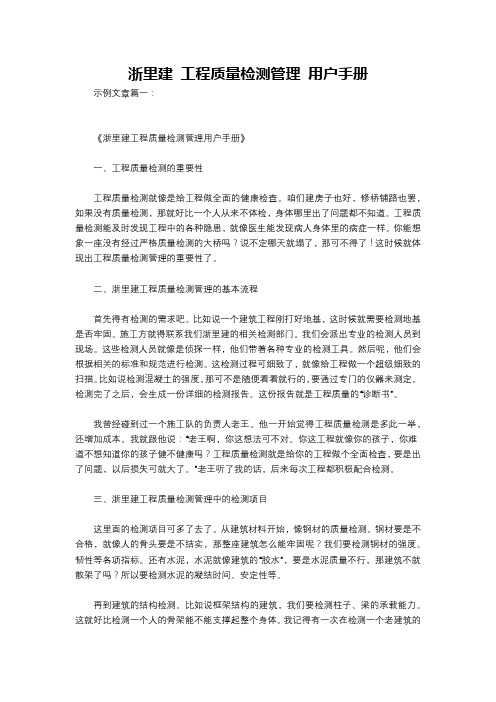
浙里建工程质量检测管理用户手册示例文章篇一:《浙里建工程质量检测管理用户手册》一、工程质量检测的重要性工程质量检测就像是给工程做全面的健康检查。
咱们建房子也好,修桥铺路也罢,如果没有质量检测,那就好比一个人从来不体检,身体哪里出了问题都不知道。
工程质量检测能及时发现工程中的各种隐患,就像医生能发现病人身体里的病症一样。
你能想象一座没有经过严格质量检测的大桥吗?说不定哪天就塌了,那可不得了!这时候就体现出工程质量检测管理的重要性了。
二、浙里建工程质量检测管理的基本流程首先得有检测的需求吧。
比如说一个建筑工程刚打好地基,这时候就需要检测地基是否牢固。
施工方就得联系我们浙里建的相关检测部门。
我们会派出专业的检测人员到现场。
这些检测人员就像是侦探一样,他们带着各种专业的检测工具。
然后呢,他们会根据相关的标准和规范进行检测。
这检测过程可细致了,就像给工程做一个超级细致的扫描。
比如说检测混凝土的强度,那可不是随便看看就行的,要通过专门的仪器来测定。
检测完了之后,会生成一份详细的检测报告。
这份报告就是工程质量的“诊断书”。
我曾经碰到过一个施工队的负责人老王。
他一开始觉得工程质量检测是多此一举,还增加成本。
我就跟他说:“老王啊,你这想法可不对。
你这工程就像你的孩子,你难道不想知道你的孩子健不健康吗?工程质量检测就是给你的工程做个全面检查,要是出了问题,以后损失可就大了。
”老王听了我的话,后来每次工程都积极配合检测。
三、浙里建工程质量检测管理中的检测项目这里面的检测项目可多了去了。
从建筑材料开始,像钢材的质量检测。
钢材要是不合格,就像人的骨头要是不结实,那整座建筑怎么能牢固呢?我们要检测钢材的强度、韧性等各项指标。
还有水泥,水泥就像建筑的“胶水”,要是水泥质量不行,那建筑不就散架了吗?所以要检测水泥的凝结时间、安定性等。
再到建筑的结构检测。
比如说框架结构的建筑,我们要检测柱子、梁的承载能力。
这就好比检测一个人的骨架能不能支撑起整个身体。
推荐一款开源的测试用例管理工具Testlink用户手册
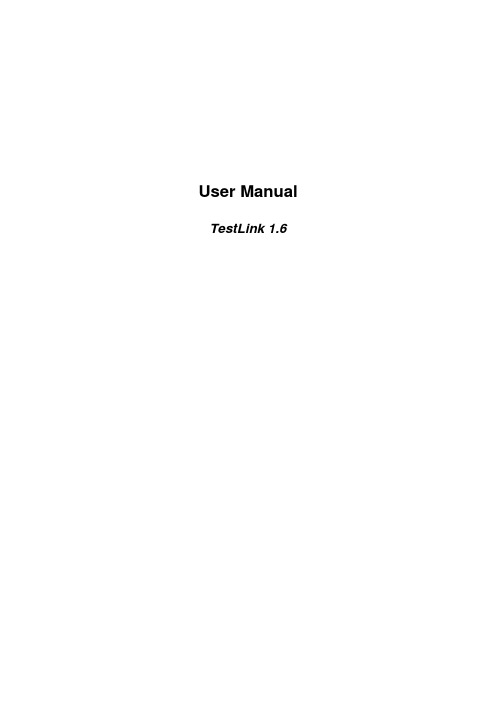
User Manual TestLink 1.6Copyright © 2004,2005 TestLink Development TeamPermission is granted to copy, distribute and/or modify this document under the terms of the GNU Free Documentation License, Version 1.2 or any later version published by the Free Software Foundation; with no Invariant Sections, no Front-Cover Texts, and no Back-Cover Texts. The license is available in "GNU Free Documentation License" homepage.1. General informationTestLink is web based Test Management system. This manual should serve as source for users to understand processes and organization of testing with TestLink. See to Installation manual for more information about system requirements, installation steps and configuration. The latest documentation is available on or .See an example of TestLink workflow:1.Administrator create a product “Fast Foo” and a user Adam with rights“leader” and Bela with rights “Senior tester”.2.Adam imports Software Requirements and for part of these requirementsgenerates empty Test cases.3.Bela describe test sneario of these Test cases that are organizedaccording to Components and Categories.4.Adam creates Keyword: “Regression” and assignes this keyword to tenof these test cases.5.Adam creates a Test Plan “Fish & Chips”, Build “Fish 0.1” and addTest Cases with keywords “Regression”.6.Adam and Bela execute and record the testing with result: 5 passed, 1failed and 4 are blocked.7.Developers make a new build “Fish 0.2” and Bela tests the failed andblocked test cases only. Exceptionaly all these five Test cases passed.8.Manager would like to see results. Administrator explain him that he cancreate account himself on the login page. Manager do it. He has “Guest”rights and could see results and Test cases. He can see that everything passed in overal report ;-) and problems in build “Fish 0.1” in a report for particular Build. But he can change nothing.2. Overall structureThere are three cornerstones: Product, Test Plan and User. All other data are relations or attributes for this base. First, definition of a couple of terms that are used throughout the documentation.2.1 Products and Test PlansProduct: A product is something that will exist forever in TestLink. Products will undergo many different versions throughout their life times. Product includes Test Specification with Test Cases and should be sorted via Keywords.Test Plan: Test Plans are created when you'd like to execute test cases. Test plans can be made up of the test cases of one or many products. Test Plan includes Builds, Test Case Suite and Test Results.2.2 Test Case CategorizationTestLink breaks down the test case structure into three levels components, categories, and test cases. These levels are persisted throughout the application.Component: Components are the parents of categories. Each component can have many categories.Category: Categories are the parents of test cases. Each category can have many test cases.Test Case: Test cases are the fundamental piece of TestLink.Test Specification: All components, categories and test cases within Product. Test Case Suite: All components, categories and test cases within Test Plan.2.3 UsersAn User has a Role, that defines available TestLink features. See more in chapter User Administration.The next picture shows common activity according to user roles:Illustration 1: Functionality overview3. Test Specification3.1 Creating Test CasesTester must follow this structure: component, category and test case. At first you create component(s) for your product. You can fill description which can be printed then. Component includes categories. Category has the similar meaning but is second level of Test Specification and includes just Test Cases.User can also copy or move Test Cases.Test Cases has next parts:∙Title: could include either short description or abbreviation (e.g.TL-USER-LOGIN)∙Summary: should be really short; just for overview.∙Steps: describe test scenario (input actions); can also include precondition and cleanup information here.∙Expected results: describe checkpoints and expected behaviour a tested product or system.3.2 Deleting Test CasesTest cases, categories, and components may be deleted from a test plan by users with lead permissions from the "delete test cases" screen. Deleting data may be useful when first creating a test plan since there are no results. However, Deleting test cases will cause the loss of all results associated with them. Therefore, extreme caution is recommended when using this functionality.3.3 Requirements relationTest cases could be related with software/system requirements as n to n. The functionality must be enabled for a product. User can assign Test Cases and Requirements via link Assign Requirements in the main screen.4. Keywords4.1 Using keywordsKeywords were created to give users another level of depth when categorizing test cases. Keywords serve as a collection of Test cases with some attribute within a Test specification. You can use it to define e.g.∙Regression or Sanity set∙Reviewed Test cases∙Set of test cases valid for one platform4.2 Keyword CreationAt this time keywords can only be created by users with the mgt_modify_key rights. These rights are currently held only by Leaders. Once a keyword or grouping of keywords have been created users may assign them to test cases.4.3 Assigning KeywordsKeywords may be assigned to test cases either from the assign keyword screen (in batch) or via the test case management (individually).4.4 Filter by KeywordUsers have the ability to filter by Keywords for:∙Search Test Cases in Test Specification.∙Add groups of Test cases in a Test case Suite (Test plan).∙Execute test screen.5. Requirement based testing5.1 IntroductionTo proof that a system is build as specified, testers use requirement based testing. For every requirement, they design one or more test cases. At the end of the test execution a test manager reports on the tests that are executed and the requirements that are covered. Based on this information the client and the various stakeholders decide whether a system can be transferred to the next test phase or can go live. To ensure that a system is build as specified, test managers use a combination of risk and requiremetn-based testing to ensure that a system is build as specified from the customer and stakeholders perspective. As a result, this complete testing delivers the following advantages:∙Linking risks and requirements will reveal vague or missing requirements.This is especially interesting for risks with a high priority.∙Testing can be focused on the most important parts of an information system first: covering the risks with the highest priority.∙Communicating in the same language as the client and the stakeholders.This makes it easier to report on the status of the test project. Beside that a better founded decision can be made whether to invest more in testing or take the risk.∙The risks and their priority make negotiating on the test project in times of pressure easier. What risks have to be covered within this test project and which ones can be postponed. Risk and requirement-based testing results in a better controlled test project. The communication with the client and the stakeholders improved. The test manager begins testing with risks with the highest priority. The process is streamlined and the end result is higher quality.5.2 AvailabilityThe functionality is available on product level. I.e. Administrator should enable it for a specified product (Edit Product link in Main window). Otherwise links are not shown.There are two user levels for this feature. The most of roles can view requirement but not modify. Refer to User section for more.5.3 Requirements SpecificationRequirements are bunched to one or more System/Software/User Requirement Specifications.Illustration 2: Dependencies between requirement related objectsCreate a document with Requirements:1.Click Requirements Specification in Main window. The List of RequirementSpecification window is shown.2.Press Create button to create a document.3.Adjust Title, Scope and eventually Count of Test cases. The lastparameter is used for statistics. Use only if you have a valid Requirement document but not all requirements are available at the moment in TestLink.Default value 'n/a' means that the current count of requirements in a specification is used.4.Press Create button to add data to database. You can see the title ofyour new created document in the table of List of Requirement Specification window.5.Click the title of document for next work. The Requirement Specificationwindow is shown.Each Requirement Specification has own statistics and report related to included data.All Specification could be printed via Print button in the Requirement Specification window. Administrator can define company, copyright and confident text via configuration files.5.4 RequirementsEach requirement has Title, Scope (html format) and Status. Title must not be unique and has max. 100 characters. Scope paramter is text in HTML format. Status can have vale VALID or NOT_TESTABLE. A NOT_TESTABLE requirements are not counted to metrics.Requirements could be created/modified or deleted manually via TestLink interface or imported as CSV file.5.4.1 Import requirementsTestLink support two types of CSV. The first 'simple' is composed from title and scope in each row. The second 'Export from Doors' try to detect header and chooses correct fields. Import compare titles and allow to solve conflicts. There are three ways: update, create requirements with same title and skip adding the conflicted ones).5.4.2 Requirements to Test Case relationTest cases are related with software/system requirements as * to *. I.e. you can assign more Test cases to one Requirement and more requirements could be covered by one Test Case. User can assign Requirements to Test Cases via the Assign Requirements link in the Main window.A coverage of Test Specification could be view via pressing the button Analyse in the Requirement Specification window.5.4.3 Requirement based ReportNavigate to Reports and Metrics menu. There is Requirements based Report link. Requirements in currect Requirement Specification and Test Plan are analysed for this report. All the latest result of test cases (available in Test Plan) are proceeded for each requirement. The result with the highest priority is applied for the requirement. Priority from the highest are: Failed, Blocked, Not Run and Passed.Example of requirement coverageA requirement is covered by three Test Cases. Two of them are includedin the current Test Suite. One passed and one was not tested for the Build1. Now Requirement has overall result: Not Run. Second test case was tested with Build 2 and passed. So Requirement passed too.6. Products6.1 OverviewProducts are the cornerstone of TestLink. Products are releases of your company that may change their features and functionality over time but for the most part remain the same.6.2 Creating new productsCreate a new product is admin right. You cannot create products with the same name. You can assign a color of backgroung to product for a better lucidity.Things to note when creating a new product:∙Deleting Products themselves is not recommended from the system, because the deletion of products would either orphan lots of test plan cases or lead to their deletion.∙Test Plans represent the testing of a product at a certain point of time.What this means is that All Test Plans are created from Product test cases.∙TestLink has the ability to import your data into a product. Data is read in CSVs form and is explained further in the import section.7. Test Plans7.1 Creating a new Test PlanTest plans are the basis for test case execution. Test plans are made up of test cases imported from products at a specific point of time. Test plans can only be created by leads. Test plans may be created from other test plans. This allows users to create test plans from test cases that at a desired point in time. This may be necessary when creating a test plan for a patch. In order for a user to see a test plan they must have the propper rights. Rights may be assigned (by leads) in the define User/Project Rights section. This is an important thing to remember when users tell you they can't see the project they are working on7.2 BuildsBuilds are a specific release of software. Each project in a company is most likely made up of many different builds. In TestLink execution is made up of both builds and test cases. If there are no builds created for a project the execution screen will not allow you to execute. The metrics screen will also be completely blank. Builds currently cannot be edited or deleted.7.3 Deleting TestPlansTest plans may be deleted from the main page by users with lead permissions. Deleting test plans permanently erases the test plan and all of its corresponding data (test cases, results, etc). The deleting of data is a scary prospect and should be reserved to extreme cases. TestLink also allows users to deactivate test plans so that they no longer appear as a menu option.8. Test Case Suite8.1 Adding new Test CasesTest Case Suite is set of test cases which are defined to be run within Test Plan. Test case Suite is created via Add Test Cases from Test Specification to Test Plan. Test cases are added including Steps and Expected result. So, you must use 'Update modified Test Cases' page to update test scenario (version of test case).Data from multiple products can be added into one test plan. Test Specification data can be filtered by keywords (adjusted in navigation pane).Once data has been imported into a test plan it will be marked with checkmark. If a test case has already been imported it will be ignored if it is imported again.8.2 Removing Test Cases from Test Case SuiteTest cases, categories, and components may be deleted from a test plan by users with Leader permissions from the "Remove test cases" page. Deleting data may be useful when first creating a test plan since there are no results. However, Deleting test cases will cause the loss of all results associated with them. Therefore, extreme caution is recommended when using this functionality.8.3 PriorityTestLink gives users with Leader rights the ability to assign ownership and priority to test cases. General Risk/Ownership is done at the category level. TestLink currently does not allow users to assign risk or ownership at the individual test case level.Risk levels are low, medium, high and Importance levels are 3, 2, 1. Users can rank the combinations of risk and importance (L1, L2, L3, M1, H2, M3, H1, H2, H3) as priority A,B,C.Assigning risk, importance, ownership, and priority are all optional and will default to priority B in the metrics screen.8.4 OwnershipOwnership affects both the execution and metrics screens. In the execution screen users have the ability to sort the executable test cases by the ones they have ownership of. In the main metrics screen there is a table that shows the remaining test cases by ownership. If there are no test case owners it defaults to none.A Tester can also see a metrics of own executed tests in main page if these metrics are enabled (see Installation manual).9. Test Execution9.1 GeneralTest execution is available when:1. A Test Specification is written.2. A Test Plan is created.3.Test Case Suite (for the Test Plan) is defined.4. A Build is created.5.The Test plan is assigned to testers (otherwise they cannot navigate tothis Test Plan).Select a required Test Plan in main page and navigate to the 'Execute tests' link. Left pane serves for navigation in Test Case Suite via tree menu, filtering and define a tested build.9.2 NavigationThe navigation pane consists from a 'Filter & Settings' box and a tree menu with Test Case Suite.9.2.1 Filtering Test CasesThis table allows the user to filter test cases for smart navigation before they are executed.∙Owner: Users can filter test cases by their owner. Ownership is determined at the category level, is determined by leads, and can be changed at the Assign Risk and Ownership page under metrics.∙Keyword: Users can filter test cases by keyword. Keywords are set either using the Create/Edit/Delete Test Cases or by the Assign Keywords To Multiple Cases. Keywords can only be created, edited, or deleted by leads but may be assigned to test cases by testers.∙Result: Users can filter test cases by results. Results are what happened to that test case during a particular build. Test cases can pass, fail, be blocked, or not be run.9.2.2 Define a tested buildUsers can filter test cases by builds. Builds are the basic component for how test cases are tracked. Each test case may be run once and only once per build. Builds can be created by leads using the Create New Build page.9.2.3 Tree menuThe tree menu in navigation pane includes Test Case Suite colored by results.Menu colored: By default the tree will be sorted by the results for the defined build that is chosen from the dropdown box.Example TC colored according to the buildUser selects build 2 from the dropdown box and doesn't check the "most current" check box. All test cases will be shown with their status from build 2. So, if test case 1 passed in build 2 it will be colored green.Second possibility Last result is that menu is colored according to the latest test result.Example TC colored according to the latest resultUser selects build 2 from the dropdown box and this time checks the "most current" check box. All test cases will be shown with most current status.So, if test case 1 passed in build 3, even though the user has also selected build 2, it will be colored green.9.3 Execution9.3.1 Test StatusExecution is the process of assigning a result (pass, fail, blocked) to a test case for a specific build. 'Blocked' test case is not possible to test for some reason (e.g. a problem in configuration disallows to run a tested functionality).9.3.2 Insert Test resultsTest Results screen is shown via click on an appropriate component, category or test case in navigation pane. The title shows the current build and owner. The colored bar indicate status of the test case. Yellow box includes test scenario of the test case.The indication that the test case was updated or deleted in test Specification is not supported in 1.5 version.Updated Test Case: Users will see the American flag if the original version of the test case (on the management side) has been updated. If users have the proper rights they can go to the update/delete test case page either through clicking on the test case number next to the flag or through the link on main page. It is not necessary for users to update test cases if there has been a change. They simply have the option of doing so if they wish.Deleted Test Case: Users will see the "x" symbol if the original version of the test case (on the management side) has been deleted. If users have the proper rights they can go to the update/delete test case page either through clicking on the test case number next to the "x" or through the link on main page.10. Test Reports and MetricsThe metrics pages sum up the results of execution into reports. Metrics are broken down by both individual builds and across all builds.10.1 General Test Plan MetricsThis page shows you only the most current status of a test plan. For instance, you have test case 1 which was executed in builds 1,2, and 3. Build 1 2 3 Status Pass Fail Blocked Since the most recent result of the test case is blocked the result on the "Across All Builds" page would be blocked. If a user would go and change the status of build 3 to something else or not run the current result would be fail.(in TL 1.0.4: View Project Status Across All Builds)10.2 Metrics of active BuildThis report shows the detailed results for a particular build defined in navigation pane.(in TL 1.0.4: View Status by an Individual Build)10.3 The Overall Build StatusView The Overall Build Status This report show a high level view of each build's result.10.4 Query MetricsQuery results for specific test cases based on keyword, component, owner, last result, and 1 or more builds. For example if you wanted to know if a test case has failed, passed, blocked, or has not been run in builds 2, 3, and 4 you would want to use this query functionality. Additionally you could determine if test cases assigned to a tester have been executed in a set of builds. This is important because test passes may occur over multiple builds, and multiple test passes may occur during the development cycle. This is especially handy at the end of a development cycle when you want to know if certain cases have been run over the past few builds of the product. This functionality differs from other reports which display results on a specific build, or all builds.Export to MS Excel is also available.10.5 Test ReportView Status By Individual Test Cases This report shows each test case's result for every build. An user can navigate to Test Execution screen via link for each test Status.Export to MS Excel is also available.10.6 Blocked/Failed Test CasesThese reports show all of the currently blocked or failing test cases. 10.7 Total Bugs For Each Test CaseThis report shows each test case with all of the bugs filed against it for the entire project. This metrics are available only if Bug Tracking System is connected.10.8 E-mail Test reportEmail Test Plan Info This page allows users to email the results of the entire test Plan or for a particular build. It also allows users to email the status of a component11. User Administration11.1 Account settingsEvery user on the system will also be able to edit their own information via the Account settings window (link Personal in menu bar).TestLink allows users with administrator rights to create, edit, and delete users within the system. However, TestLink does not allow administrators to view or edit user's passwords. If users forget their passwords there is link on the login screen, that will mail the user their password based upon their user name and the email address they entered.11.2 Role PermissionsTestLink is built with 6 different default permission levels built in. Changing of these rights is handled by the user administration link which is accessible by admins. These permission levels are as follows:∙Guest: A guest only has permission to view test cases and project metrics.∙Test Executor: A tester outside of the company that only has permissions to run tests allotted to them. (initially in 1.0.4 - otester)∙Test Designer: A user can fully work with Test Specification and Requirements.∙Test Analyst: A tester can view,create, edit, and delete test cases as well as execute them. Testers lack the permissions to manage test plans, manage products, create milestones, or assign rights. (initially tester, senior tester)∙Test Leader: A lead has all of the same permissions as a Tester but also gains the ability to manage test plans, assign rights, create milestones, and manage keywords∙Admininstrator: An admin has all of the same permissions as a lead but gains the ability to manage productsNote: Test plan related features needs also assign a Test Plan to be available. See Test Plan Assignment.11.2.1 User RolesThere are predefined user roles. Adminstrator gives appropriate ability to modify data within TestLink. Each user has assigned just one of these roles. If you view the table you will see rows for each of the permissions levels (guest ,tester, senior tester, leader, admin). The column next to the row holds all of the different rights levels which will be defined below. These levels have been determined as standard for the use but they are free to be edited or define a new roles (for experienced administrator). The user table contains a foreign key that points to the appropriate permission level in the rights table. RoleList of Rights Ability Guest mgt_view_tc, mgt_view_key, tp_metrics Browse data only.Test Executor tp_execute,tp_metricsExecute test only. Test Analyst tp_execute,tp_metrics, tp_create_build, mgt_view_tc,mgt_modify_tc, mgt_view_key, mgt_view_req Edit test Specification and execute tests.Test Designer tp_metrics, mgt_view_tc, mgt_modify_tc, mgt_view_key, mgt_modify_req, mgt_view_req Edit Test Specification and Requirements.Test Leader tp_execute, tp_create_build,tp_metrics, tp_planning, tp_assign_rights, mgt_view_tc, mgt_modify_tc, mgt_view_key, mgt_modify_key, mgt_view_req, mgt_modify_reqAll Test Plan right, edit test Specification and execute tests. Administrator tp_execute, tp_create_build, tp_metrics, tp_planning, tp_assign_rights, mgt_view_tc, mgt_modify_tc, mgt_view_key, mgt_modify_key, mgt_view_req, mgt_modify_req, mgt_modify_product, mgt_users Everything possible. Only this role can maintain products and users. Table 1: Role description11.2.2 Rights DefinitionsNext tables list keywords used for definition of role abilities.RightDescription mgt_view_tc Viewing Test Specification (data of component, category, and testcase)mgt_modify_tc Edit Test Specification (create,modify,delete,order, move, and copycomponents, categories, and test cases)mgt_view_keyViewing keywordsRight Descriptionmgt_modify_key Modifying keywordsmgt_modify_product Create,edit and delete productsmgt_view_req View requirementsmgt_modify_req Create,edit, associate and delete requirements Table 2: Product related RightsRight Descriptiontp_execute Ability to execute test cases (insert test results) tp_create_build Ability to create buildstp_metrics Viewing metricstp_planning create, edit, delete Test Plans, assign risk/ownership, milestones, edit Tes Case Suitetp_assign_rights Assigning the rights to view projectsTable 3: Test Plan related Rights11.3 Test Plan AssignmentUsers can see only assigned Test Plans. In order to gain test plan permissions a user with lead or admin status must give them rights through the “Define user/project rights” link under “Test Plan Management”.All users in the system will by default not have permissions to view newly created test plans (except for the test plan creator who can give themselves permissions at creation). Zero test plan permissions means that users will not see any Test Plans in the Test Plan dropdown box on main screen.There is a table with Test Plan rights (i.e. which users can see which Test plan). This table is made up of a combined user id and project id. The main page contains code which checks to see if the logged in user has the appropriate permissions (and then shows the allowed projects. It is not recommended that this be hacked with.。
SmartClass Ethernet测试仪 用户手册
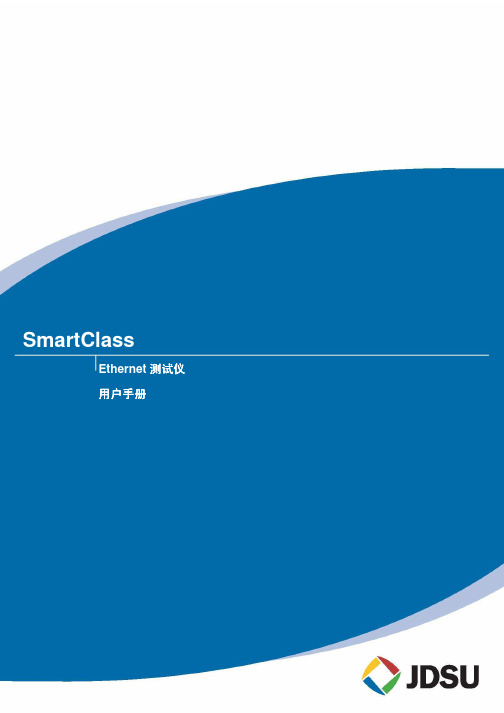
第1章
开始..................................................................................................... 1
装箱清单.............................................................. 2
底部面板介绍.......................................................... 7
启动设备.............................................................. 7
关闭设备.............................................................. 7
不能将此产品作为市政污染废料进行处理,并且根据当地国家相关规则单独收集 处理。在欧盟地区,所有从 JDSU 公司 2005.8.13 日之后购买的设备可以在设 备使用寿命完毕时返回处理。JDSU 公司确保所有返回的废弃设备能够以环境友 好型方式进行重新使用、回收或处理,这些操作都要符合所有国家和国际废料处 理标准。
SmartClass Ethernet 测试仪用户手册
v
目录
第2章 第3章
vi
数据输入屏 ....................................................................................................10 结果屏............................................................................................................10 使用键盘 ............................................................ 11 选择菜单选项或配置设置............................................................................... 11 返回到上一级菜单.......................................................................................... 11 输入数字值 ....................................................................................................11 输入文本 ........................................................................................................11
QC测试管理工具使用手册

QC测试管理工具使用手册QC测试管理工具使用手册1、简介1.1 概述本文档是针对QC测试管理工具的使用手册,旨在帮助用户熟悉QC测试管理工具的各项功能及操作步骤。
1.2 目的通过本手册,用户将能够全面了解QC测试管理工具的使用方式,并能够灵活地应用该工具进行项目的测试管理。
1.3 读者对象本手册适用于所有需要使用QC测试管理工具进行项目测试管理的人员,包括测试工程师、测试经理等。
2、安装2.1 系统要求在安装QC测试管理工具之前,请确保您的计算机符合以下最低系统要求:- 操作系统:Windows 7或更高版本- 内存:至少4GB- 硬盘空间:至少10GB2.2 安装步骤1、QC测试管理工具安装包,双击运行安装程序。
2、根据安装向导的提示,选择安装路径和其他相关设置。
3、等待安装完成。
4、启动QC测试管理工具。
3、用户登录和权限管理3.1 用户登录1、打开QC测试管理工具。
2、在登录界面输入您的用户名和密码。
3、单击“登录”按钮。
3.2 权限管理QC测试管理工具支持多种用户权限管理,包括管理员、测试经理、测试工程师等,您需要联系系统管理员进行权限的分配和管理。
4、创建项目4.1 新建项目1、在QC测试管理工具主界面,单击“新建项目”按钮。
2、输入项目名称、描述以及其他相关信息。
3、单击“确定”按钮。
4.2 导入项目1、在QC测试管理工具主界面,单击“导入项目”按钮。
2、选择项目文件所在路径。
3、单击“导入”按钮。
5、项目管理5.1 项目概览在该模块中,您可以查看项目的基本信息、进度、成员等。
5.2 测试计划管理在该模块中,您可以创建、编辑和执行测试计划,包括测试用例的编写、测试集的管理、测试环境的配置等。
5.3 缺陷管理在该模块中,您可以创建、编辑和跟踪项目中出现的缺陷,包括缺陷的录入、分配、修复、验证等。
5.4 进度跟踪在该模块中,您可以跟踪项目的进度,包括测试用例执行情况、缺陷修复情况等。
6、报表和分析6.1 测试报告在该模块中,您可以项目的测试报告,包括测试计划执行情况、缺陷统计、测试成本等。
AT526C 交流电阻测试仪 用户手册说明书

用户手册User’s GuideRev.A5固件说明:适用于主程序Rev.E3及以上的版本AT526C交流电阻测试仪负载测量功能43/4位交流电阻读数,6位直流电压读数电阻测试范围:0.000mΩ~33.000Ω电压测试范围:0.0000V~60.0000VDC0.5%的电阻准确度,0.05%的电压准确度RS-232C接口@& % anbai安柏是常州安柏精密仪器有限公司的商标或注册商标。
常州安柏精密仪器有限公司Applent Instruments Ltd.江苏省常州市钟楼区宝龙61-3层 销售服务电子邮件:*****************技术支持电子邮件:****************©2005-2015 Applent Instruments Inc.2 AT526C 用户手册安全须知当你发现有以下不正常情形发生,请立即终止操作并断开电源线。
立刻与安柏科技销售部联系维修。
否则将会引起火灾或对操作者有潜在的触电危险。
●仪器操作异常。
●操作中仪器产生反常噪音、异味、烟或闪光。
●操作过程中,仪器产生高温或电击。
●电源线、电源开关或电源插座损坏。
●杂质或液体流入仪器。
安全信息为避免可能的电击和人身安全,请遵循以下指南进行操作。
免责声明 用户在开始使用仪器前请仔细阅读以下安全信息,对于用户由于未遵守下列条款而造成的人身安全和财产损失,安柏科技将不承担任何责任。
仪器接地 为防止电击危险,请连接好电源地线。
不可在爆炸性气体环境使用仪器 不可在易燃易爆气体、蒸汽或多灰尘的环境下使用仪器。
在此类环境使用任何电子设备,都是对人身安全的冒险。
不可打开仪器外壳 非专业维护人员不可打开仪器外壳,以试图维修仪器。
仪器在关机后一段时间内仍存在未释放干净的电荷,这可能对人身造成电击危险。
不要使用已经损坏的仪器 如果仪器已经损害,其危险将不可预知。
请断开电源线,不可再使用,也不要试图自行维修。
不要使用工作异常的仪器 如果仪器工作不正常,其危险不可预知,请断开电源线,不可再使用,也不要试图自行维修。
CCC免办及特殊用途进口产品检测处理管理系统企业用户使用手册
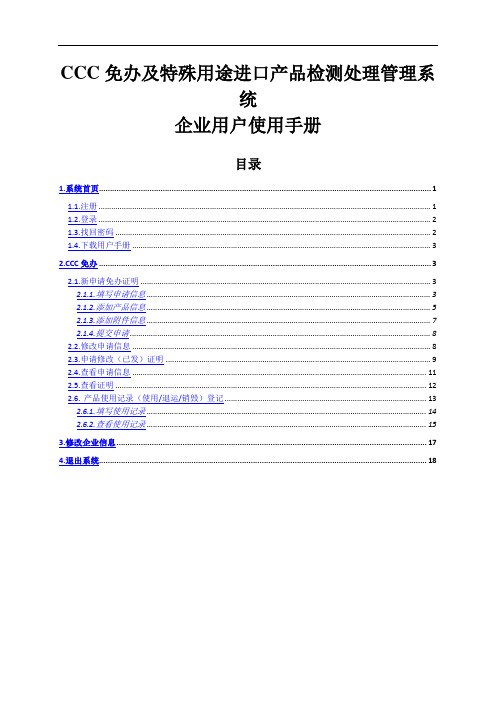
CCC免办及特殊用途进口产品检测处理管理系统企业用户使用手册目录1.系统首页 (1)1.1.注册 (1)1.2.登录 (2)1.3.找回密码 (2)1.4.下载用户手册 (3)C免办 (3)2.1.新申请免办证明 (3)2.1.1.填写申请信息 (3)2.1.2.添加产品信息 (5)2.1.3.添加附件信息 (7)2.1.4.提交申请 (8)2.2.修改申请信息 (8)2.3.申请修改(已发)证明 (9)2.4.查看申请信息 (11)2.5.查看证明 (12)2.6.产品使用记录(使用/退运/销毁)登记 (13)2.6.1.填写使用记录 (14)2.6.2.查看使用记录 (15)3.修改企业信息 (17)4.退出系统 (18)1.系统首页打开浏览器,在地址栏中输入CCC免办及特殊用途进口产品检测处理管理系统的网址,打开系统首页:(图:系统首页)企业用户在系统首页,可以查看认监委发布的信息,在左侧的用户登录栏可进行以下操作:注册新用户使用系统前,需要先注册,再登录。
登录注册成功后,输入用户名、密码,通过系统验证,方可登录系统。
忘记密码如果登录用户忘记密码,点击“忘记密码”按钮,可通过用户邮箱或手机号码找回密码。
下载使用文档右下方的企业用户可以点击‘用户操作手册下载’链接按钮,下载用户使用手册。
1.1.注册初次使用系统的企业,需要先在系统首页注册用户。
点击“注册”按钮,弹出注册用户声明页面:(图:企业注册)按照要求填写注册资料,星号标注的是必填信息。
填写完毕,点击“注册”按钮,验证通过即可完成注册;点击“重填”按钮,可以清空输入的信息,并重新填写。
注意:一个组织机构代码可以注册多个用户,当修改某一用户信息时,修改的‘申请单位’、‘申请单位邮编’、‘申请单位地址’、‘申请单位信息备注’字段信息会对所有该组织机构代码下的用户生效。
联系人邮箱地址尽量使用比较规范的邮箱地址,有些公司邮箱是不能收到找回密码功能发送的验证码邮件的。
《测试系统信息管理-用户手册》

测试信息管理系统软件使用说明书版本号:V1.0 作者:盛泉根华立仪表集团股份有限公司2010-07目录一、前言 (1)二、运行环境 (1)三、主要工作流程 (1)四、主要管理环节的使用方法 (2)1.系统基本信息管理 (2)1.1 系统用户管理 (2)1.2 系统人力资源管理 (5)1.3 测试设备管理 (6)1.4 产品信息管理 (7)1.5 产品样表标识管理 (8)2.测试任务管理 (8)2.1 测试总任务管理 (8)2.2 测试任务清单管理 (9)2.3 测试任务分派管理 (11)2.4 测试任务单打印 (12)2.5 测试任务执行情况检查 (13)2.6 测试任务执行情况跟踪 (14)3.测试报告管理 (15)3.1 测试报告编辑 (16)3.2 测试报告汇总和审核 (19)3.3 测试报告的核验 (21)3.4 测试报告的审核 (23)3.5 测试报告的查询 (23)3.6 测试报告和测试记录的打印 (24)华立仪表集团股份有限公司测试信息管理系统软件使用说明书版本号:V1.0 作者:盛泉根 2010-7-15一、前言本系统软件适用于电能表产品制造行业,具体用于电能表产品测试部门的测试计划任务管理、测试报告档案管理、测试记录数据管理,也可以推广到相类似制造企业的产品测试信息管理。
本软件的技术特点是为产品测试部门建立了测试信息管理平台。
涉及到电能表产品测试信息管理的各项基础管理,包括员工信息、岗位职责、工作流程、工作规范、测试规范、测试设备、技术标准。
本软件主要的三大模块,测试任务管理模块:总任务编制和子任务分派管理,包括任务进度管理和测试人员工作量管理。
测试报告管理模块:子报告编辑平台和总报告自动汇总,包括测试报告的审核和批准、报告的打印和查询。
二、运行环境本管理系统软件需要安装配置服务器、终端工作站和局域网,运行的硬件和软件环境为:硬件环境软件环境服务器HP 双CPU2.44G/内存4096M/硬盘300GWindows Server 2003Microsoft Access2003/2007工作站Lenovo CPU1.83G/内存1024M/硬盘100GXP/2003/Vista三、主要工作流程本系统软件为电能表产品制造行业的产品测试部门定向开发,也适用于类似的仪器仪表制造业的产品测试部门的信息管理,典型的工作流程如下:典型的电能表产品测试工作流程四、主要管理环节的使用方法1.系统基本信息管理 1.1 系统用户管理 初始登录系统,需要系统管理员为各个用户登记著录用户名,按用户的角色将用户分配到用户组,一个用户可以被分配到若干个用户组。
安捷伦 Lab Advisor 用户手册
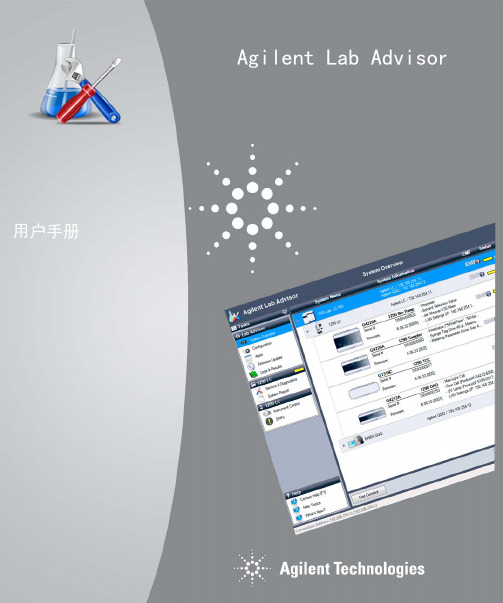
Agilent Lab Advisor 用户手册Agilent Technologies声明© 安捷伦科技有限公司, 2016-2018根据美国和国际版权法,未经 Agilent Technologies, Inc. 事先同意和书面许 可,不得以任何形式、任何方式(包括 存储为电子版、修改或翻译成外文)复 制本手册的任何部分。
手册部件号M8550-97007 Rev. B版本05/2018Germany印刷Agilent TechnologiesHewlett-Packard-Strasse 876337 Waldbronn 担保说明本文档内容按 “ 原样 ” 提供,在将来的版本中如有更改,恕不另行通知。
此外,在适用法律允许的最大范围内,Agilent 对本手册以及此处包含的任何信息不作任何明示或暗示担保,包括但不仅限于适销性和针对某一特殊用途的适用性的暗示担保。
对于因提供、使用或执行本手册或此处包含的任何信息而产生的错误,或造成的偶然或必然的损失,Agilent 不承担任何责任。
如果 Agilent 与用户签订了单独的书面协议,其中涉及本文档内容的担保条款与这些条款冲突,则以协议中的担保条款为准。
技术许可本文档中所述的硬件和 / 或软件是根据许可提供的,只能根据此类许可的条款进行使用或复制。
权力限制说明美国政府受限权利。
授予联邦政府的软件和技术数据权利仅包括通常提供给最终用户的那些权利。
Agilent 根据FAR12.211(技术数据)和 12.212(计算机软件)和 (对于国防部)DFARS252.227-7015 (技术数据 -商品)以及DFARS 227.7202-3(商业计算机软件或计算机软件文档中的权利)来提供软件和技术数据方面的此常规商业许可。
安全警告小心提示表示危险。
提醒您注意某个操作步骤、某项操作或类似问题,如果执行不当或未遵照提示操作,可能会损坏产品或丢失重要数据不要忽视小心提示,直到完全理解和符合所指出的条件。
Tiptop管理员手册
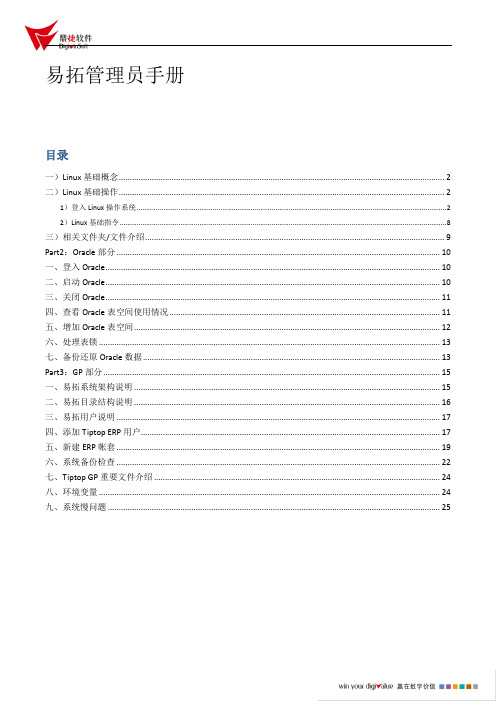
易拓管理员手册目录一)Linux基础概念 (2)二)Linux基础操作 (2)1)登入Linux操作系统 (2)2)Linux基础指令 (8)三)相关文件夹/文件介绍 (9)Part2:Oracle部分 (10)一、登入Oracle (10)二、启动Oracle (10)三、关闭Oracle (11)四、查看Oracle表空间使用情况 (11)五、增加Oracle表空间 (12)六、处理表锁 (13)七、备份还原Oracle数据 (13)Part3:GP部分 (15)一、易拓系统架构说明 (15)二、易拓目录结构说明 (16)三、易拓用户说明 (17)四、添加Tiptop ERP用户 (17)五、新建ERP帐套 (19)六、系统备份检查 (22)七、Tiptop GP重要文件介绍 (24)八、环境变量 (24)九、系统慢问题 (25)Part:1 OS部分一)Linux基础概念1)和Windows一样,Linux是一种操作系统,一样有文件、进程、磁盘分区各种概念。
2)不同于Windows,Linux的维护是在命令行界面完成,因此需要掌握一些Linux维护指令。
3)根据28定律,我们只要掌握20%的指令,就可以完成80%的维护操作了。
4)现在开始万里长征第一步:登入Linux,以便进行对Linux的操作。
二)Linux基础操作1)登入Linux操作系统1)推荐下载安装XShell最新版本登入OS,方便日后操作启动XShell 点击New 新建一个到AP操作系统的链接2)点击Connection选项,设定以下栏位的值:Name 连线标识,如:ERP-APHost AP的IP地址3)点击Authentiacation选项,设定以下栏位的值:User Name rootPassword root账户的密码,默认为tiptop4)点击Terminal选项,设定以下栏位的值:Encoding Unicode(UTF-8)5)点击OK,完成连线设置。
KIC2000用户使用手册
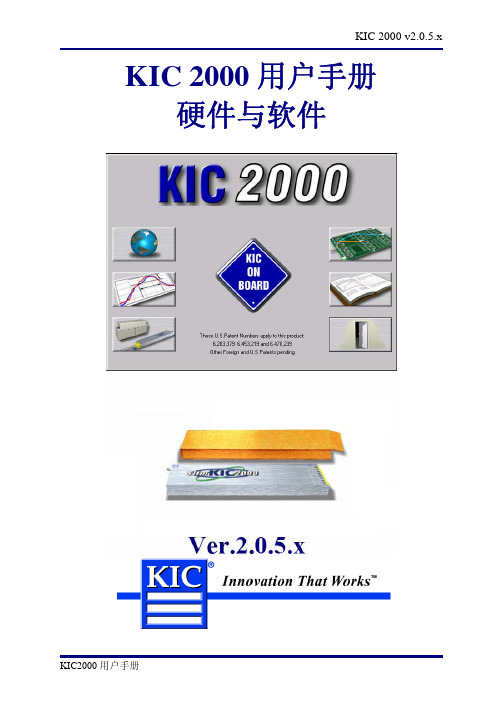
KIC2000 用户手册
制成工艺设置
KIC 2000 v2.0.5.x
取消这个复选框,对 每个热电偶进行参数 定义。参照以下细 节。
制程工艺窗口名(Process Window Name) – 为你的制程工艺窗口文件命名。制程工艺窗口文件包含数据统 计选项信息和这些数据统计的界限。你在下面的描述区域里输入的文字也会一起保存在文件里。 • 锡膏清单(Solder Paste Menu) – 一个只读的并列入了众多通过锡膏制造商得到的有着统计数据和界限建
安装KIC 2000 软件
在安装KIC2000软件之前,为了避免软件冲突你可将所有其它正在运行的应用软件关闭。这是一个很好的 习惯当你在装任何一个软件。
请根据如下步骤安装软件: • 把贴有Disk 1 of 5 磁盘插入A盘驱动器中。 • 点击运行Windows Start 。 • 打入A: setup 并且按下回车键。 • 根据屏幕上的提示安装程序。
经插入线缆并已通电。 • 接收器上的红灯应该是开着的。 • 如果你用的是数据存储版本,则确保你的下载线已经插在PC上的COM端口并且另外一端的8针也插进了
SlimKIC 2000.
2. 从主菜单进入到综合参数设置 (左上角的按钮)
• 为轨道速度,距离,温度和重量选择单位。设置最大产品起始温度,为了准确地触发曲线测量,所有 用来做曲线的热电偶都必须在这温度以下。最好是设置平均室温加5摄氏度,或者保留默认设置。
KIC2000 用户手册
KIC 2000 v2.0.5.x
SlimKIC 2000 Hardware
Inventory
元件描述
SlimKIC 2000 通讯电缆 电源 (仅限于无线传输版本) 隔热套 热电偶 (9或 12) 用于附着热电偶的铝皮Aluminum Tape 和高温焊锡 SlimKIC 2000 用户手册 KIC 2000 软件
ISO10012测量管理体系手册及全套文件
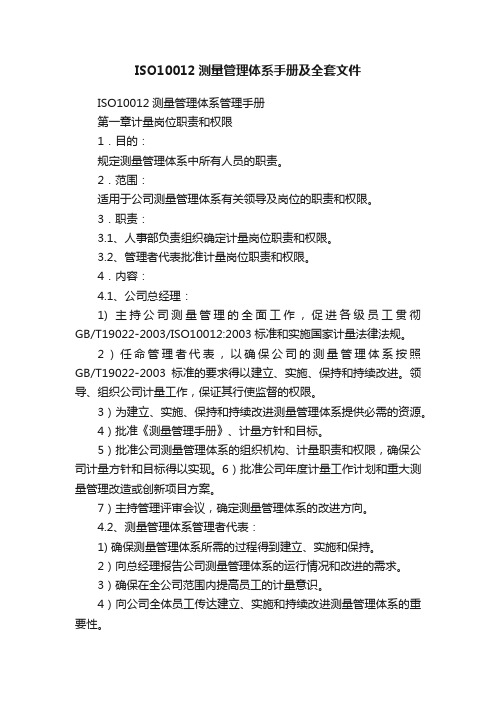
ISO10012测量管理体系手册及全套文件ISO10012测量管理体系管理手册第一章计量岗位职责和权限1.目的:规定测量管理体系中所有人员的职责。
2.范围:适用于公司测量管理体系有关领导及岗位的职责和权限。
3.职责:3.1、人事部负责组织确定计量岗位职责和权限。
3.2、管理者代表批准计量岗位职责和权限。
4.内容:4.1、公司总经理:1) 主持公司测量管理的全面工作,促进各级员工贯彻GB/T19022-2003/ISO10012:2003标准和实施国家计量法律法规。
2)任命管理者代表,以确保公司的测量管理体系按照GB/T19022-2003标准的要求得以建立、实施、保持和持续改进。
领导、组织公司计量工作,保证其行使监督的权限。
3)为建立、实施、保持和持续改进测量管理体系提供必需的资源。
4)批准《测量管理手册》、计量方针和目标。
5)批准公司测量管理体系的组织机构、计量职责和权限,确保公司计量方针和目标得以实现。
6)批准公司年度计量工作计划和重大测量管理改造或创新项目方案。
7)主持管理评审会议,确定测量管理体系的改进方向。
4.2、测量管理体系管理者代表:1) 确保测量管理体系所需的过程得到建立、实施和保持。
2)向总经理报告公司测量管理体系的运行情况和改进的需求。
3)确保在全公司范围内提高员工的计量意识。
4)向公司全体员工传达建立、实施和持续改进测量管理体系的重要性。
5)在测量管理体系建立、实施和保持过程中与咨询、认证机构保持联络。
6) 组织制定并审核公司测量管理手册、计量方针和目标。
7) 批准测量管理体系程序文件。
8) 任命内部审核组长,开展公司测量管理体系内部审核。
9) 审核公司计量工作年度计划和重大测量管理改造或创新项目方案。
4.3、公司工程师等:1)协助总经理、管理者代表开展计量管理工作。
2)监督管理各自分管部门的计量工作。
4.4、质量部(计量职能部门):1) 组织制定公司计量工作年度计划和重大测量管理改造或创新项目方案。
国家学生体质健康标准测试数据管理与报送系统用户手册

督促上报>>审核数据>>上报数据>>确认完成。
系统开网时间:2018年09月20日
— 7—
帐号找回申请
系统开网时间:2018年09月20日
— 8—
查看学生基础数据
可查看全校数据 ,也可按年级、班级组合选择查看
— 9—
下载数据模板
如不选择年级、班级下载体测数据模板,下载全校学生数据 ,如选择年级、班级后,下载体测数据模板,可按照年级、 班级分批下载学生数据。
系统开网时间:2018年09月20日
— 12 —
学生体测项目单位
— 13 —
标准数据范围说明
— 14 —
学生体质数据上报
点击上传按钮,选择已编写完成的学生体质 测试数据表,上报数据。
— 15 —
学生体质数据上传
一、
若未上传成功,需重新上传数据
注:系统页面显示数据校验状态,若校验状态为上传成功时,可 关闭当前页面。
二、 三、
Байду номын сангаас
四、
此状态下,可查看学生体 — 16 — 测成绩
查看数据上报情况
— 17 —
下载学生体质成绩回执单
可按照全校下载学生回执单,也可以按照年 级、班级下载学生回执单
注:学生测试数据上传成功后,即上传状态显示为计
算得分完毕时,可点击“下载学生体质成绩回执单”
按钮,下载或打印回执单,反馈给学生进行确认。
— 18 —
学生体质数据上报
— 19 —
登记卡打印
— 20 —
登记卡打印页面
查看毕业成绩
— 21 —
查看受检/未检人数
可全校或按照年级、班级查看
查看上传情况
测试报告及用户手册

测试报告及⽤户⼿册测试报告测试原则:所有的测试都应追溯到⽤户需求。
测试必须基于“质量第⼀”的思想去开展各项⼯作。
⽹站计划应该在测试⼯作真正开始前的较长时间内进⾏。
测试应从“⼩规模”开始,逐步转向“⼤规模”。
测试⽤例是设计出来的,不是写出来的。
穷举测试是不可能的。
为了达到最佳效果,应该由独⽴的第三⽅来构造测试。
不充分的测试是不负责任的;过分的测试也是⼀种不负责任的表现。
由于学业上时间安排关系以及团队匮乏开发经验,可能我们没能测完全部,当bug是程序员进步的动⼒。
⽤户注册模块测试项注册功能设计者詹佳丰,冯丽茂环境要求与服务器可以正常连接软件:IE6.0浏览器以上测试⽅法⼿⼯测试⿊盒测试输⼊说明点击注册链接填写注册信息,其中所填写的“⽤户名”、“邮箱”、“密码”、只⽀持数字,“邮箱”需要正确的形式,“密码”只⽀持英⽂和数字,“名字”不⽀持特殊符号,点击提交按钮。
输出标准界⾯提⽰信息:注册成功当输⼊信息不符合要求时要有提⽰失败的话,显⽰注册失败具体的失败原因特殊要求进⼊到⽹站⽤户注册⾸页⽤例之间的依赖性⽆序号输⼊数据期望值实际值1点击“注册”链接进⼊注册界⾯进⼊注册界⾯2不输⼊任何注册信息,点击“提交按钮”提⽰表单不能为空显⽰注册成功3在全部输⼊框输⼊空格,点击“提交”按钮提⽰表单信息⽆效显⽰注册成功4“⽤户邮箱输⼊框”不填,其余输⼊框正常填写信息,点击“提交按钮”提⽰“⽤户邮箱”不能为空显⽰注册成功5“⽤户名字”不填,其余输⼊框正常填写信息,点击提交按钮提⽰“⽤户名不不能为空”显⽰注册成功⽤户登录模块测试项⽤户登录功能设计者罗绍坤邓仁宁环境要求与服务器可以正常连接环境要求与服务器可以正常连接软件:IE6.0浏览器以上测试⽅法⼿⼯测试⿊盒测试输⼊说明输⼊账户和密码,点击登录输出标准页⾯显⽰当前登录⽤户特殊要求邮箱已注册过⽤例之间的依赖性在注册模块⽤例成功序号输⼊数据期望值实际值1不输⼊“邮箱”和“密码”信息,点击“登陆”按钮提⽰表单信息不能为空不能提⽰表单信息不能为空2输⼊已注册邮箱,不输⼊密码,点击“登陆按钮”提⽰密码不能为空⽤户名或密码错误3输⼊密码“123”,不输⼊“邮箱”,点击“登陆按钮”提⽰⽤户名不能为空⽤户名或密码错误4输⼊没注册过的“⽤户名”,输⼊错误密码,点击“登陆”提⽰“⽤户名或密码错误”提⽰“⽤户名或密码错误”5输⼊注册过的“⽤户名”,输⼊正确密码,点击“登陆”页⾯显⽰的登陆信息页⾯显⽰的登陆信息管理员登录模块测试项管理员登录功能设计者杨⼦龙陈志权环境要求与服务器可以正常连接软件:IE6.0浏览器以上测试⽅法⼿⼯测试⿊盒测试输⼊说明管理员进⼊后台登录页⾯输⼊“⽤户名”和“密码”点击“登录”按钮输出标准进⼊到后台管理页⾯并显⽰当前登录管理员特殊要求只有管理员才有权限登录⽤例之间的依赖性⽆序号输⼊数据期望值实际值1不输⼊“⽤户名”和“密码”信息,点击“登陆”按钮提⽰“⽤户名或密码错误”提⽰“⽤户名或密码错误”2输⼊已分配的管理员,不输⼊密码,点击“登陆按钮”提⽰“⽤户名或密码错误”提⽰“⽤户名或密码错误”3不输⼊分配的管理员”⽤户名”,输⼊“密码”,点击“登陆按钮”提⽰“⽤户名或密码错误”提⽰“⽤户名或密码错误”4输⼊已分配的管理员,输⼊错误“密码”,点击“登陆按钮”提⽰“⽤户名或密码错误”提⽰“⽤户名或密码错误”5输⼊没注册过的“⽤户名”,输⼊错误密提⽰“⽤户名或密码错误”提⽰“⽤户名或密码错误”户名”,输⼊错误密””码,点击“登陆”6输⼊分配的管理员“⽤户名”,输⼊正确“密码⽤户⼿册2.填写信息进⼊登录界⾯进⾏登录3.登录之后跳到主页,点击进⼊个⼈资料页⾯4.在左下⾓点击编辑,进⾏编辑个⼈资料5.提交后调回个⼈信息页⾯6.点击查询-----精确查找,可以按条件查询会员7.在主页的左下⾓,可以在成功案例这⾥添加⾃⼰的故事8.这样在主页其他会员就可以看到你的故事9.最后如果有什么疑问,可以点击关于我们,跟我们联系10并且在主页右下⾓,如果可以请赞助我们,你的赞助就是对我们最⼤的⿎励。
- 1、下载文档前请自行甄别文档内容的完整性,平台不提供额外的编辑、内容补充、找答案等附加服务。
- 2、"仅部分预览"的文档,不可在线预览部分如存在完整性等问题,可反馈申请退款(可完整预览的文档不适用该条件!)。
- 3、如文档侵犯您的权益,请联系客服反馈,我们会尽快为您处理(人工客服工作时间:9:00-18:30)。
目录MYPM业务流程 (4)1关于MYPM1.1简介“MYPM”是一套专注于IT领域,专门为IT企业定制的集成化项目管理解决方案。
一方面,她把ISO9000和CMMI管理体系以软件形式组织起来,使之具有可实施性和引导性,从而帮助企业把项目管理体系建立和组织起来,并能以便捷的方式在实际项目中引入和实施;另一方面,她把计划、任务及进度管理,工时成本管理,知识管理,质量管理,文档管理及搜索等整合到一个集成化平台中,进行统一的分析管理,企业管理层和项目中所有成员(包括客户)通过这一集成化平台进行协作和沟通,全方位对计划,资源,进度,工时,成本,质量,风险进行把控,任何一项发生变化都会反映到项目关联的其它各个部分。
当前版本为只开放测试管理功能永久免费版。
商业版在线体验地址为;免费版在线体验地址为。
1.2版权声明MYPM集成化项目管理平台版权归北京嘉通软科技有限公司所有,任何侵犯版权的行为将被追究法律责任。
未经版权所有者的书面准许,不得将本软件的任何部份以任何形式、采用任何手段(电子的或机械的,包括照相复制或录制)、或为任何目的的,进行复制或扩散。
免费版只要不用于商业目的,不受此限制。
Copyright(C)2008-2010北京嘉通软科技有限公司。
版权所有,复制必究。
北京嘉通软科技有限公司不对因为使用该软件、用户手册中的缺陷所造成的任何损失负责。
2MYPM基本约定2.1页面布局2.2数据展示区记录选择在MYPM数据展示区内,只要点击了某行记录,则在点击工具栏上的功能按钮时,将处理点击的记录。
2.3人员选择窗口缺省加载记录MYPM人员选择窗口缺省加载时,如人员多于100人,缺省显示按登录名升序排序的前100名。
2.4部分工具栏图标说明2.5MYPM业务流程3管理员使用指南3.1MYPM业务流程(免费版只有测试管理功能)3.23.2用户管理“admin”为MYPM内置的管理员帐户,“删除“及“停用”对其无效。
系统初始化后,管理员(admin)要做的第一件事是:以管理员登录MYPM后,在用户管理或系统管理菜单下“修改个人信息”中修改管理员默密码及其eamil。
3.2.1导入用户点击工具栏上的excel图标,(2)下载用户导入模板,(3)打开下载的模板,按模板格式要求填写导入数据并保存,(4)在用户导入窗口中点击“浏览”按钮,选择填写了用户信息的模板文件,然后点击“导入”执行导入(该功能从商业版中分离时,忘加进来)。
3.2.2新建用户点击工具栏上第一个带加号小人图标,输入各项信息后点击“确定”或“确定并继续”完成用户的新建。
重名校验时,把己删除用户计算在内。
3.2.3修改用户点击想要修改用户所在行,然后点击工具伴上第二个斜插着一支笔的小人图标,修改完成后按“确定”保存所做修改。
重名校验时,把己删除用户计算在内。
3.2.4切换用户状态MYPM用户有“启用”和“禁用”两种状态,缺省为“启用”状态,“禁用”的用户不许再登录系统,“禁用”用户登录时,提示信息为:“用户名或密码错误”。
点击想要切换状态的用户所在行,再点击工具栏上第三个颜色暗淡的小人图标,切换用户状态。
3.2.5重置用户密码点击想要切换状态的用户所在行,再点击工具栏上第四个钥匙图标,切重置用户密码为”mypm”。
3.2.6删除用户逻辑删除mypm中的用户3.2.7用户组管理一个用户可从属于多个组,一个组可含多个用户;组不具有权限,只是便于用户的查找一群用户的一个集合。
组与用户的关系,可双向维护(即可以在用户维护中指定其所属组,也可以在组维护中指定其成员)。
3.3权限管理MYPM的权限细划到“按钮”级,权限授予到角色对像上,用户通过从属于角色来获得所从属的角色的权限,如用户从属于多个角色,其权限人多个角色权限的并集。
如设定了角色的访问IP,则其内用户只能在指定的这些IP上登录MYPM。
免费版IP登录限制功能无效。
另外还有一个特殊的与工作职责相关的双重角色:测试负责人,他们在获得相关测试管理权限基础上,同时还要在某个测试项目中担任测试负责人,才可以管理相应的项目。
4使用手册4.1通用使用指南4.1.1定制首页分为单列表和多列表两种定制方式,默认首页为“项目列表”,在多列表首页中个人工作台被禁用。
下图为多列表登录首页。
4.1.2消息管理MYPM中的消息为公告性质的消息,其效期有时限,即只有在生效期限内的消息可被查看。
发布消息发布消息列表显示本人发布的所有消息发布消息操作界面如下图消息类型有广播和限定接收入两种,类型为限定接收入时,且选择MAIL告知,接收入会收到mail提醒。
在公告内容中插入图片,在“附件/插图片”中选择要插入的图片,然后点“浏览”按钮右边的带加号图标,即可在公告内容当前光标中插入图片。
修改消息只能修改未生效和己失效的消息,接收消息显示未失效的广播消息和本人接收到的消息消息维护可以修改,删除所有人员发布的消息,也可发布消息4.1.3缺陷处理BUG采用流程驱动,登录MYPM后,缺省显示当前流转到本人的BUG。
在BUG列表中点击测试人员,对BUG进行意见交流;双击BUG编号关联测试用例,双击BUG状态处理BUG,如BUG当前不需要本人处理,则显示BUG明细。
如下图所示。
MYPM中有25种缺陷状态(为系统的测试分析提供依据),同时又不增加用户的使用难度,MYPM缺陷控制引擎会自动根据测试流程,缺陷当前状态及处理人员在项目的角色,引导操作人员处理缺陷,无需关心测试流程。
如下图所示,在“更改状态为”下拉列表中,可选的状态就是缺陷控制引擎自动计算出来的,选择某个状态后,系统会自动引导BUG的下一步流转,切换到处理历史页,可以查看BUG的处理历史。
4.1.4测试需求管理,测试用例管理和缺陷管理菜单切换规则在切换到测试需求管理,测试用例管理和缺陷管理菜单时,会自动记住最后处理的测试需求或测试用例,或缺陷所属的测试项目,切换菜单后处理的也是同一项目的相关数据。
比如,从测试需求切换到缺陷管理时,缺省显示测试需求管理中进入的测试项目的缺陷;又例如,在缺陷列表中,点击了某个BUG,再切换到用例管理时,默认切换到该BUG所属测试项目的用例管理。
4.1.5测试用例和缺陷编号快速查询在用例管理列表页面,和缺陷管理列表页面,都可以通过在工具栏上输入他们的编号来实现精确皮配查询测试用例或是缺陷。
编号快速查询后,点击工具栏上的“刷新”按钮,列表显示复原为编号快速查询前的显示内容。
4.1.6修改个人信息在系统管理菜单下,点击“修改个人信息”子菜单,便可修改当前登录人员的个人信息4.1.7测试基础数据维护维护下面11类测试基础数据测试用列类:用例优先级和用例类型BUG管理类:BUG频率,BUG类型,BUG等级,BUG时机,BUG优先级,BUG来源,BUG引入原因,BUG引及阶段,BUG发生平台。
如图所示数据项为蓝色的表示系统缺省的,缺省的不可以删除,只要以停用,只有自定义的测试基础数据可以被删。
新建测试基础项4.2测试经理/测试负责人使用指南4.2.1测试基础数据维护同通用使用指南4.1.7部分的测试基础数据维护,如果认可MYPM缺省的测试基础数据,不需要再自行维护测试基础数据。
4.2.2测试项目管理及简介MYPM测试管理业务流程如下,位于测试管理/测试项目管理菜单下MYPM的测试项目有两个来源,一个是来源于项目管理中项目WBS中定义的测试任务;另一个来源是不纳入项目管理的独立测试项目。
来源于项目WBS的测试任务不可以删除。
测试项目指定了测试负责人以后,该测试项的管理权将转移支测试负责人,当然前提还要求,这个测试人要管理测试项目的权限。
除管理员外,其他人员“可见”的测试项目为本人参与的测试项目;对于来源于项目管理中项目WBS中定义的测试任务,对于其任务所在项目的参与人员来说,都是“可见”的。
对于免费版无来源于项目管理中项目WBS中定义的测试任务。
独立测试项目与来源于项目WBS的测试任务的区别独立测试项目可以被删除和修改测试项目停息,后者不可以独立测试项目,测试测试流程选择参与人员时,从整个MYPM系统内选择,而后者是人该测试任务参与人员和该测试任务所从属的项目的PM和PSM中选择。
独立测试项目可以附加测试计划附件,后者不可以。
在测试项目管理列表中,来源于项目WBS的测试任务,如项目计划未确定,将不在该列表中显示。
4.2.3创建测试项目建立测试项目最基本流程(1)建测试项目(2)设置测试流程(3)提交测试需求为必须流程。
测试管理/测试项目管理菜单下,从工具栏新建按钮中新建测试项目,输入如图4.2.3.2测试流程及软件版本设置在MYPM中,对于每个测试项目,可以从MYPM提供的流程中选取部分或全部流程作为当前项目的测试流程,测试过程中可以实时调整测试流程。
在测试项目列表中,点击项目名称可以设置测试流程,也可在测试管理/测试流程|版本管理菜单下,点击项目名称进入测试流程设置页面。
在流程设置中主要完成的工作:1设置流程2指定在各个流程节点上的相关人员3设置被测试软件版本;另外一旦在测试流程设置中,指定了测试负责人(可以有多个),该测试项目将交由测试负责人来管理,以后只有他可以更改流程的各流程上节点上的处理人员,当然测试负责人还要有设置测试流程的权限。
如图所示,执行顺序为从上到下。
在流程设置页面中,切换到“版本维护”,设置软件版本;设置版本时,序号应随版本号增长,不可重复,也不可以和被逻辑删除的版本序号重复,如己提交测试需求,删除版本时,为逻辑删除;己停用的版本,不在选择版本的下拉列表中列出。
来源于项目WBS的测试任务,如项目计划未确定,将不可以设置测试流程。
各流程节点说明1用例Review:可选流程.如果用例Review流程没有被选取,新提交的测试用例,状态为“己审核”状态,审核人为自动审批(既用例编写人)。
用例Review人员一般为业务人员,测试负责人,需求人员或开发人员。
2提交问题:必选流程,人员主要为测试人员,不是提交问题这流程节点上的人员也可填报BUG,只是不能确认BUG是否己修复。
3测试互验:可选流程,当测试人员和开发人员不在同一地点办公时,或想测试把关新手提交的BUG时,开启该流程,由资深测试人员来做测试互验,既可以指导新人编写高质量的BUG,也可以在开发人员在处理BUG前,测试人员内部先检查新提交的BUG,省去了可能的因BUG描述理解差异上,或是BUG可复现上带来的和研发人员的沟通成本。
4分析问题:可选流程,分析BUG产生的原因,估算修复BUG需要的时间及期限,一般为研发经理,系统分析师来做分析工作。
5分配问题:可选流程,单元测试时,或团队规模比较小且测试人清晰的知道开发人员所负责的模块时,可以不启用该流程,测试人员提交的BUG,直接分配给开发人员。
